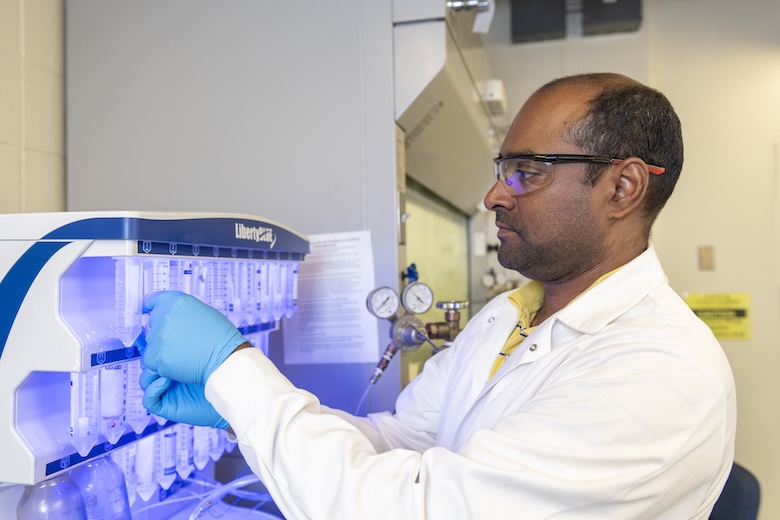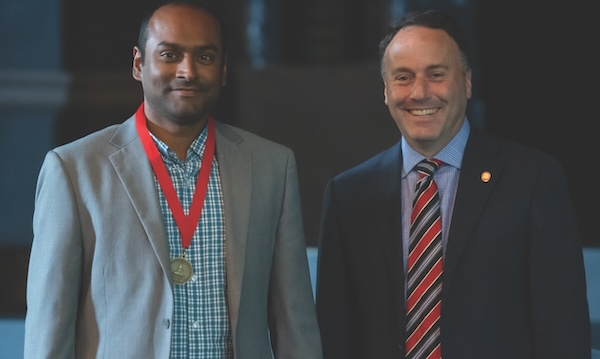
Saumen Chakraborty, associate professor of chemistry and biochemistry, in his lab at Coulter Hall. Photo by Srijita Chattopadhyay/ Ole Miss Digital Imaging Services
OCTOBER 31, 2023 BY STAFF REPORT
Saumen Chakraborty is an associate professor of chemistry and biochemistry with major research awards from the National Institutes of Health and the Oak Ridge Associated Universities and an exemplary record of impressive publications describing his work.
“The Chakraborty group of both undergraduate and graduate students does significant research that lies at the interface between biochemistry and inorganic chemistry and focuses on exploring the role of metals in biology,” a colleague said. “But beyond the science, Dr. Chakraborty’s primary motivation is to help students achieve academic excellence and professional growth.”

Saumen Chakraborty (left) receives the Dr. Mike L. Edmonds New Scholar Award in 2022 for achievements in research from Lee M. Cohen, dean of liberal arts. Photo by Kevin Bain/The University of Mississippi Marketing Communications
Recipient of the College’s Dr. Mike L. Edmonds New Scholar prize in 2022 for achievements in research, Chakraborty joined the faculty in 2016 from the Los Alamos National Laboratory where he was a postdoctoral researcher.
“Life on Earth is critically dependent on metal ions,” he said. “Good metals are necessary for survival as they help us breathe and produce energy for daily functions. However, to make this happen, metal ions must be associated with biomolecules such as proteins that impart unique properties and functions. Naturally, any imbalance in the function of metal ions can lead to severe health complications.
“The laboratory utilizes protein design to explore the role of metal ions in biology to create ‘artificial’ systems capable of alternative energy production (e.g., green hydrogen) and enabling chemical reactions that can produce value-added chemicals such as drug scaffolds.”
Graduate students in his lab acquire technical aspects of this interdisciplinary field and become independent and intellectual research professionals who pursue their careers in an academic or pharmaceutical setting. Chakraborty is a big proponent of training female students and enables them to excel in their respective disciplines. One of his recent female graduate students is a postdoc at Johns Hopkins University School of Medicine. Another female graduate works as a staff scientist at Stanford University ChEM-H center established by the 2022 Chemistry Nobel Laureate Prof. Caroline Bertozzi. Two other recent female graduates are employed in the pharmaceutical industry.
Katy Howie, a doctoral student from Grand Blanc, Michigan, with a masters from the University of Tennessee Health Center, studies metal binding proteins for green energy production and cancer treatment research with Chakraborty. “I am working with a multi-metal binding protein for hydrogen production for a source of hydrogen gas as an energy source as well as a heme-binding protein that assists in cancer cells’ ability to evade the immune system.”
Undergraduate students learn basic biochemical skills in his laboratory; most perform research as part of their Honors thesis requirements.
“The technology that Dr. Chakraborty’s lab pursues has the promise of reducing our dependence on carbon-based fuels and decreasing atmospheric CO2 levels,” a colleague noted. “In his short career here, Dr. Chakraborty has laid the foundation for a world class, transformative research program in metalloprotein catalyst design for environmental and industrial applications.”